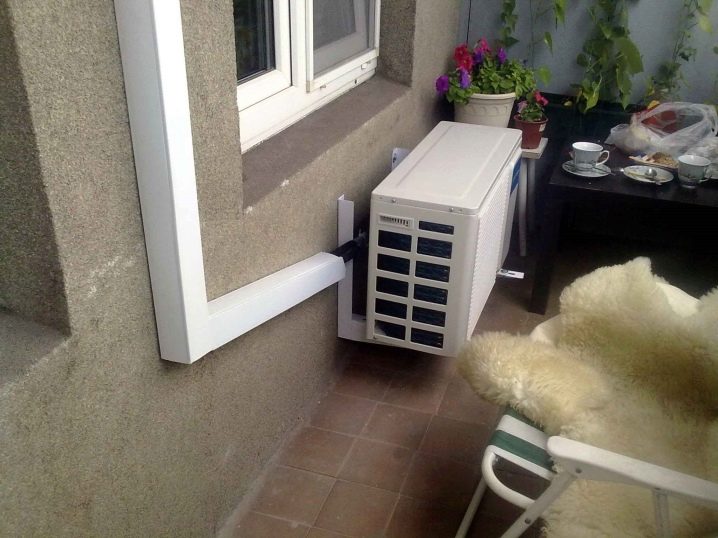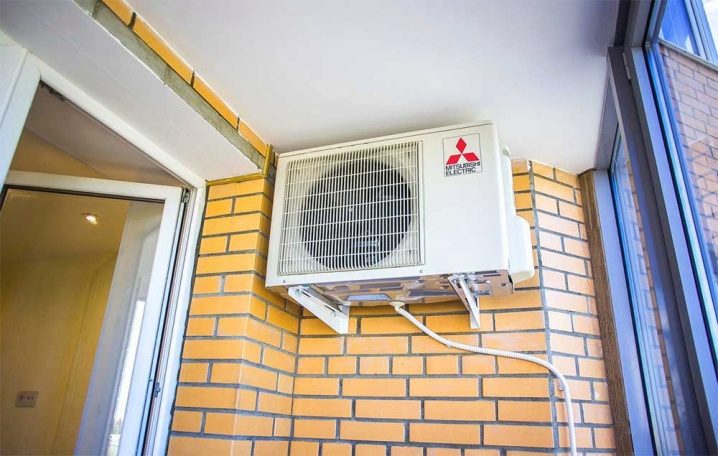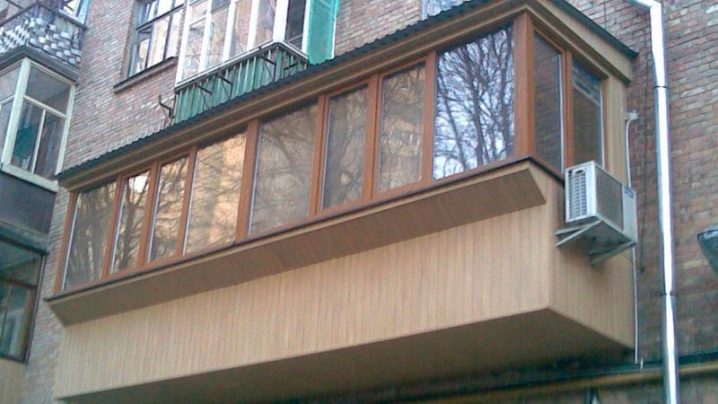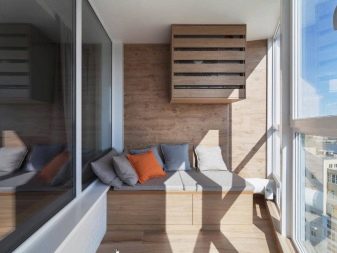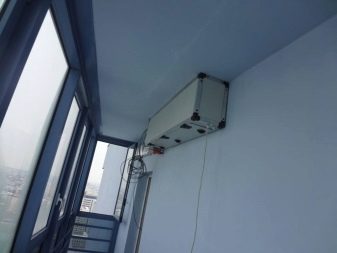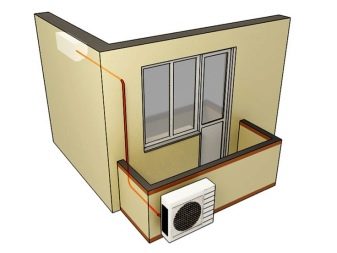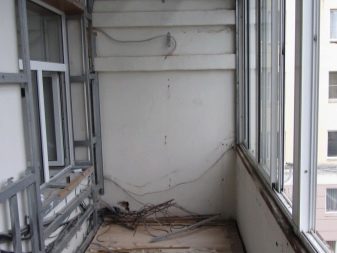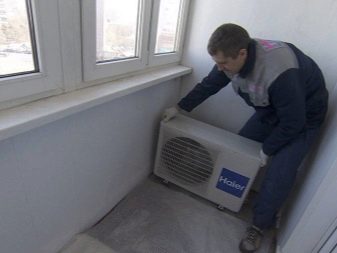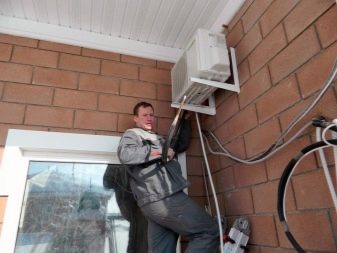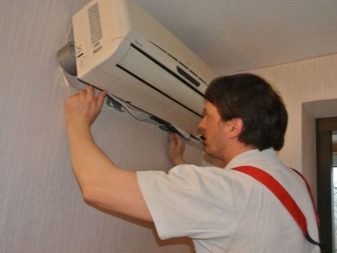Installation of an air conditioner on the balcony and loggia with glazing
Significant warming due to the reduction of forest areas around the world has led to the need to install an air conditioner in every apartment or country house in most of Russia. Some apartment owners have air conditioning on their balconies.
Advantages and disadvantages
Installing an air conditioner on a simple, open balcony is easy. This device does not even need to be fixed on the wall - it is installed on the riser, which is located on the balcony floor (slab). In the case of glazing, this task can be complicated. This also includes a loggia - a glazed built-in balcony, which is not a suspended external space of the house, but located within the bearing walls. Installing an air conditioner on the balcony has a number of advantages.
-
Easy and safe installation of the device. Installation workers or the owner and his family members who install it on their own do not run the risk of falling down themselves while performing work, or dropping the outdoor unit. And it is also possible to demolish other outdoor blocks and other devices and objects installed on the wall of the house, damage someone's balcony (or loggia), sidewalk and more.
-
Due to the closedness of the glassed-in balcony or loggia, the external block is securely sheltered from atmospheric influences, dust raised by the wind, and smog. Outdoor unit cleaning is quicker and easier.
-
The outdoor unit can be cleaned quickly and easily. You do not need to be tied with insurance and lean out of the window, go to the parapet or windowsill with a pressure washer sprayer, use multi-section ladders, ask the housing office for access to the roof (keys to the attic), climb fire escapes or rent a truck crane.
-
Installation costs (mains, insulation, electric cables with frost, heat, moisture and ultraviolet resistant insulation, corrugation for the cable cord), freon (refrigerant) are significantly reduced.
However, there are also disadvantages of installing an air conditioner on a glazed balcony.
-
The need to slightly open the windows on the balcony during the operation of the outdoor unit. If this is not done, then the temperature on the balcony will rise to +60 or more, which will cause premature damage to some things stored on the balcony or loggia, the penetration of heat into the cooled rooms through the thermal conductivity of metal-plastic windows, doors and wall sections. The cold from the room will begin to compensate for this heat, which tries to penetrate the room through the solid structures that separate the balcony from this room. Such processes will start a cycle that contributes to the inefficiency of the cooling system and the rapid failure of the outdoor unit due to the total overheating of parts, including the case. In the presence of an emergency shutdown circuit, the unit, having reached the same 60 degrees, will automatically shut down from overheating.
-
The outdoor unit is rather bulky - it takes away from a third to a half of a cubic meter of free space.
-
Noise is not lost on the street in the space surrounding the unit, it does not dissipate. It reflects off the interior surfaces of the balcony, creating an acoustic effect similar to the bass reflex of a speaker at low frequencies. The hum interferes with sleep at night, rest in the afternoon and evening. It prevents especially sensitive people from concentrating, for example, on remote work, which requires constant concentration of attention.
To decide whether to install the outdoor unit on the balcony, weigh all these advantages and disadvantages. Whether you are ready to refuse to go out on the balcony in the summer due to the fact that it is hot all the time depends on you.
Fundamental rules
Air conditioning is not a single unit as it once was. Window air conditioners are produced in very limited quantities. The principle of operation of a split air conditioner is the heating of freon during its liquefaction and sharp cooling during evaporation. The heat in the external unit is blown out by the fan in the external unit, and the cold is blown out by the second cooler in the internal unit, already into the room itself. It is impossible to hang the indoor unit closer than a decimeter to the ceiling - it will create an additional obstacle for the fastest and most efficient cooling of the air in the room.
You cannot direct the flow of cold air to places where people are often - a sofa, a writing or computer table, an interior door, and more. You or your family members run the risk of catching a cold, and sudden changes in temperature weaken the body's defenses.
By placing the indoor unit above a cabinet or in other places where a lot of dust collects, you run the risk of inhaling this very dust every time you start the device. The place for installing the indoor unit should be easily accessible - for the purpose of facilitated and accelerated maintenance or repair.
Where to install?
The external unit of the split air conditioner cannot be installed on the wall of a building that is an architectural and historical heritage. The owner of a high-rise building, a residential office can also impose a ban on the installation of any foreign objects, household appliances and electronics on the walls. Installation on a balcony with glazing (or without glazing) is the only way out.
Outdoor installation, as well as wall mounting, can disturb neighbors. Outdoor units create decent noise comparable to street ones - 60-70 dB.
If one of the last floors is often exposed to gusty / stormy winds, then the air flow hitting the front side of the unit slows down the operation of the fan, which may cause it to break prematurely.
Summer heat, solar ultraviolet light lead to premature shedding of insulation, cables and gaskets that are part of the device. Frequent showers, the proximity of the house to the sea or ocean can lead to the fact that the iron casing and all steel parts and components of the outdoor unit, including its suspensions, rust through and collapse. During a storm, the excitement of the sea raises into the air a plume of the smallest splashes of salt water, which are carried by the wind in all directions.
The parapet outside can be, for example, near a poplar, which has grown to the 7th floor and touches the outdoor unit with its branches when swinging in the wind. Autumn leaf fall becomes the reason for the drift of leaves in the interior of the block, which closes technological gaps and gaps. The heating main for the air conditioner, that is, the freon circulation tubes, should be as long as possible. The same applies to the condensate drainage unit, which should not drain onto the facade of the house, balconies or loggias of apartments located under yours.
The parapet of a regular or stained glass balcony is exposed to parasitic vibrations that eventually destroy the balcony. To prevent the entire structure from collapsing, additional brackets must have a damper (shock absorbers), in the simplest case, which is a layer of rubber.
On a glazed balcony, it is recommended to install an air conditioner outside on the parapet - when the windows of the glazed balcony or vents do not open. Make sure that the structure of the suspended part of the balcony is sufficiently reliable: the weight of the outdoor unit, depending on the capacity, reaches 60 kg.
When the outdoor unit is installed on an outside wall of a house that opens onto a balcony, make sure that the wall itself is sufficiently reinforced.Despite its thickness and the materials from which the load-bearing walls of the house are built, the wall can transmit noise. This will require room wall soundproofing.
The drainage pipe is installed in a place that prevents water droplets from flowing down the facade. The best way is to drain this drain into your home garden or sewer.
A mobile air conditioner only needs openings for supplying fresh air to the exhaust unit and removing heated (exhaust) air. The disadvantage is the increased noise level, as is the case with the old format window air conditioner.
Mounting
The indoor unit is installed in a room bordering a balcony. If the costs for the length of the heating main and the supplying electric cables are not critical, then the heating main can be brought to the next room, where this unit will be installed. This method is good for any houses - Lenin's era, "Stalin", "Khrushchev", "Brezhnev" or new building, erected after the 90s of the twentieth century.
Preparation
Remove foreign objects from the balcony that interfere with installation. Remove the debris left after moving things and objects. Attach additional brackets and hangers with shock absorbers to the desired location. Bring a separate 220 volt power line to the location of the indoor unit, equipped with an additional automatic fuse, which must be installed in a place protected from moisture.
Technology
The indoor unit is installed first. Before hanging it in the room, attach the freon pipes to it. It is advisable to use copper ones - they allow more bends. Copper is an elastic metal that is resistant to cracks and fractures, which cannot be said, for example, about aluminum. Use the hex adapter nipples supplied with the air conditioner or purchased separately.
Install the outdoor unit after leading the pipes out into the drilled through hole for them. Connect the heating pipes according to the manufacturer's instructions. Drill another hole for the power supply and control (signal) cables. The software (control) board controls the operation of the compressor, evaporator and coolers. Connect the outdoor and indoor units by referring to the setup manual.
Making sure that the software-functional unit is working, pump (evacuate) the freon path of the air conditioner using the vacuum pumping equipment. The completeness (level) of the vacuum is controlled using pressure gauges installed in the suction path of the pump. Using gas equipment, pump freon into the system. Bring the freon pressure to the required condition (according to the instructions), using the readings of the pressure gauge in the compressor supercharger path. Check the tightness of the connections on the heating main, then start the air conditioner.
Signs of normal operation are the declared level of air cooling inside, in the room itself. For a specific area of rooms, the number of degrees is indicated by which the temperature will drop when the air conditioner is operating in maximum cooling mode. The experiment should preferably be carried out in the absence of direct sunlight. And also one of the heat transfer tubes should not freeze out until a thick layer of snow-like mass appears on it.
Possible problems
Do not install pipes with insufficient diameter. The air conditioner will not provide the desired level of cooling. The compressor (freon propulsion unit) will prematurely burn out due to overload.
Uninsulated pipes can cause mold and mildew to form on the wall due to the ingress of condensed water on the wall.
Do not skimp on the quality of the sealing gaskets. Freon will leak out over time, and the air conditioner will turn off more and more often. Possible compressor breakdown.
Insecure fastening of the outdoor unit may cause it to move to the side during operation due to vibration, which may result in pipe breakage and refrigerant leakage.
Installing an air conditioner on the loggia in the video below.



